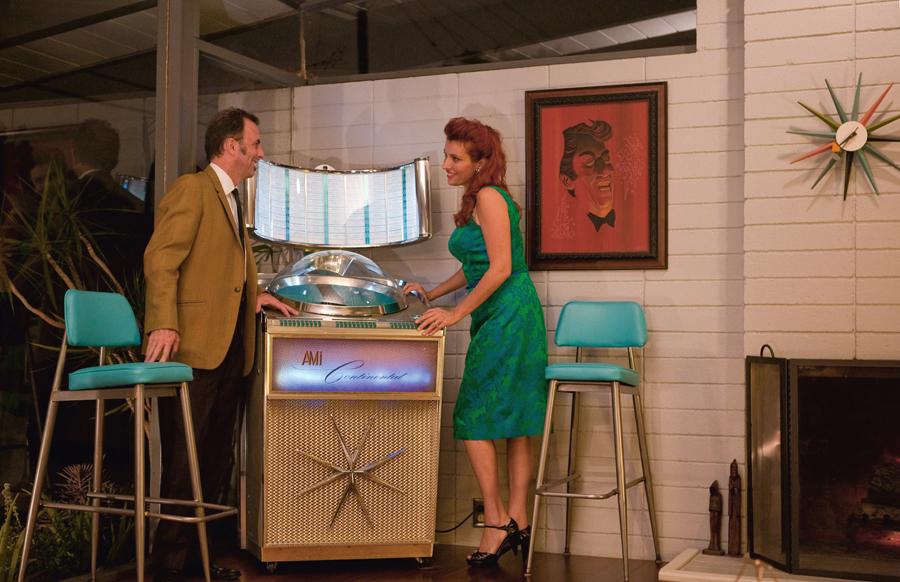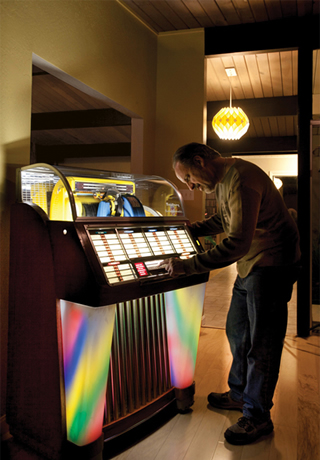The Box that Rocks - Page 2
 |
|
|
 |
|
|
 |
|
|
 |
|
|
During the 1930s, jukeboxes were credited with causing juvenile delinquency—and during World War II, for preventing it and for boosting patriotism instead.
By the time rock ‘n’ roll rolled around in the ‘50s, the jukebox industry had already begun its long, incessant slide, as radio’s top-40 stations replaced jukeboxes as the place where hits were made, and TV kept folks glued to the couch. Peak production of jukeboxes came in 1947—99,000. By 1953, the number had fallen to 59,000.
The rapid suburbanization that took hold in the ‘50s also hurt jukeboxes, Kerry Segrave wrote in his Jukeboxes: An American Social History, by keeping people “more distant from drinking spots.”
What saved the jukebox during the ‘50s, Chris Ryan wrote in London’s Guardian in 1989, was “the new cult of the teenager. Rhythm and blues, rockabilly, and rock ‘n’ roll were becoming popular but received little radio play. The jukebox became the focal point of ‘50s youth culture.”
Throughout the ‘50s, the jukebox let people share their favorite songs during sock hops and frat house bashes—and at parties thrown by Dino for his Rat Pack friends.
“You can imagine, I dunno, Sammy Davis, those guys, pushing the buttons on it,” says Dennis, who received his jukebox as an engagement gift from Cassendre. It came with a letter of provenance from Dino’s wife asserting it had really been his.
Ironically, it was the jukebox that gave radio the idea for the top-40 format—playing the same few songs over and over in heavy rotation. Heavy rotation, of course, wasn’t to everyone’s taste.
“For a solid hour,” the New York Times reported on March 2, 1948, “…Miss Josephine Ostoloco, 20 years old…fed quarters into the jukebox of the Arco Bar and Grill at 916 Ninth Avenue and listened with obvious relish to a recording of ‘Civilization’…”
Remember that tune? “Bingo, bango, bongo—I don’t want to leave the Congo, no, no, no, no, no, no…”
When Ostoloco sought change for a dollar bill so she could play it again, the Times went on, Filipe Torres shot her twice, and the bartender as well when he intervened. “The tune had no charm for him,” the reporter observed.
No, the real reason jukeboxes still live is they are a compelling social medium—anti-social, in some cases.
Jukeboxes were simply not designed to be listened to alone. Has there ever been a jukebox with earphones?
Well, yes. In fact, what some historians consider the very first jukebox could play only one song and to only one person at a time—while holding a tube against his ear. Louis Glass’s nickel-per-song ‘Coin-o-Graph’ debuted at a saloon on Sutter Street in San Francisco, of all places, was an immediate success, and stimulated much competition.
But the jukebox didn’t become a social medium until 1906, when John Gabel’s ‘Automatic Entertainer’ used an amplifying horn that allowed a crowd to share the sounds. And it wasn’t until 1927, as the Automatic Music Instrument Co. (AMI) created the first electrically amplified box, when the music really grew loud.
By the 1930s folks began calling them ‘jukeboxes,’ the name coming from African-American ‘jook joints’ in the South, and ultimately, some say, from the word ‘jouk,’ which to Englishmen in Shakespeare’s day meant ‘dance.’




